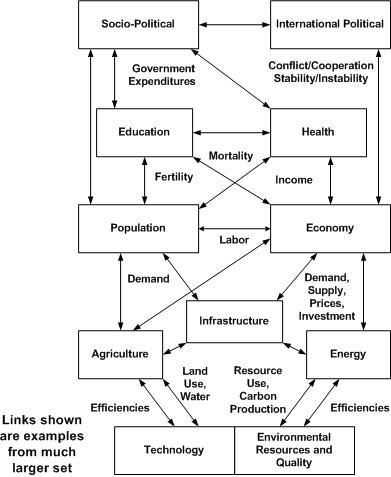Introduction to IFs
Purposes
International Futures (IFs) is a tool for thinking about long-term global futures. It assists with:
- Understanding the state of the world
- Exploring trends and considering where they might be taking us
- Learning about the dynamics of global systems
Thinking about the future we want to see:
- Clarifying goals/priorities
- Developing alternative scenarios (if-then statements) about the future
- Investigating the leverage various agent-classes have in shaping the future
Assumptions that underlie IFs development and use:
- Global issues are become more significant as the scope of human interaction and human impact on the broader environment grow
- Goals and priorities for human systems are becoming clearer and are more frequently and consistently enunciated
- Understanding of the dynamics of human systems is growing rapidly
- The domain of human choice and action is broadening
What can you investigate with IFs? Examples include:
- Environmental Sustainability: Atmospheric carbon dioxide levels, world forest area, fossil fuel usage
- Social/Political Change: Life expectancy, literacy rate, democracy level, status of women, value change
- Demographic Futures: Population levels and growth, fertility, mortality, migration
- Food and Agriculture: Land use and production levels, calorie availability, malnutrition rates
- Energy: Resource and production levels, demand patterns, renewable energy share
- Economics: Sectoral production, consumption, and trade patterns and structural change
- Global System: Country and regional power levels
IFs Issues and Modules: Visual Representation
Among the philosophical premises of the International Futures (IFs) project is that the model cannot be a "black box" to users and be truly useful. Model users must be able to examine the structures of IFs in order (1) to have confidence in them, and (2) learn from them.
Dominant relations
Any computer simulation or other model will have some relationships and dynamics that dominate the behavior of the model and that therefore most heavily influence the analyses done with the model. Understanding these dominant relations will facilitate model use, particularly in the definition of key or framing scenarios.
The value added by more detailed specification of relationships in the model will lie partly in more probing analysis, often around specific policy options. Much of the value added by a more complete model specification will, however, lie in the dynamics of the full model.
For an introductory summary of dominant relations and dynamics by submodule:
- Dominant Relations: Agriculture
- Dominant Relations: Demography/Population
- Dominant Relations: Economics
- Dominant Relations: Education
- Dominant Relations: Energy
- Dominant Relations: Environment
- Dominant Relations: Governance
- Dominant Relations: Health
- Dominant Relations: Infrastructure
- Dominant Relations: Interstate Politics
- Dominant Relations: Socio-Political
Structure-Based and Agent-Class Driven Modeling
The Structure-Based, Agent-Class Driven approach has five key elements methodologically: organizing structures, stocks, flows, key aggregate relationships, and key agent-class behavioral relationships.
Organizing structures are well-recognized and theoretical and conceptual frameworks with an organizing character for important human systems: cohort-component structures for demographic systems, markets for economic systems, financial flows for socio-political-economic systems, and so on.
Stocks and flows remind us of systems dynamics. In demographic systems, the stocks are numbers of people in age- and sex-specific cohorts, while the flows are births, deaths, and migration. Systems dynamics would deal with the key relationships as auxiliaries, but econometrics would recognize them as equations that require empirical estimation.[1]
Key Aggregate Relationships. Life expectancy or mortality is a key aggregate relationship, clearly a function of income, perhaps education, and certainly of technological change. Aggregate Relationships are often actually Agent-Class behaviors that have not yet been decomposed enough to represent in terms of a single agent class. For instance, life expectancy is a function of government and firm spending on R&D as well as household life-style choices; it could eventually be decomposed to the agent-class level.
Key Agent-Class Behavioral Relationships. For example, in the case of fertility, there is one primary agent-class, namely households, whose behavior, as a function again of income, education, and technology, will change over time.
Agent-classes versus micro agents. IFs is not agent-based in the sense of models that represent individual micro-agents following rules and generating structures through their behavior. Instead, IFs instead represents both existing macro-agent classes and existing structures (with complex historic path dependencies), attempting to represent some elements of how behavior of those agents can change and how the structures can evolve. Although building aggregate model behavior and structure upward from micro agent behavior is laudable in more narrowly-focused models, global systems and structures are far too numerous and well-developed for such efforts to succeed across the breadth of concerns in IFs.
In representing the behavior of agent classes and the structures of systems, IFs draws upon large bodies of insight in many theoretical and modeling literatures. Although IFs sometimes breaks new ground with respect to specific sub-systems, its strengths lie primarily in the integration and synthesis of much earlier work.
- ↑ this is a reference
